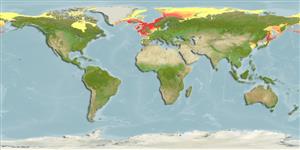Pycnogonida |
Pantopoda |
Nymphonidae
Environment: milieu / climate zone / depth range / distribution range
Ecology
Benthic; depth range 0 - 911 m (Ref. 119523). Temperate
Arctic, Northeast Atlantic and Northwest Pacific. Temperate to polar.
Length at first maturity / Size / Weight / Age
Maturity: Lm ? range ? - ? cm
This is an epibenthic species (Ref. 95730), that inhabits shelf areas (Ref. 19). Feeds on various hydroids epizoic on the bryozoan Flustra foliacea. Chemically attracted to various hydroid species, found to feed exclusively on hydroids, i.e. starves if no hydroids are present (Ref. 121217).
Life cycle and mating behavior
Maturity | Reproduction | Spawning | Eggs | Fecundity | Larvae
Members of the class Pycnogonida are gonochoric and sexually dimorphic. During copulation, male usually suspends itself beneath the female. Fertilization occurs as the eggs leave the female's ovigers. Males brood the egg masses until they hatch. Life cycle: Eggs hatch into protonymphon larva then to adults.
Child, C.A. 1995 Pycnogonida of the Western Pacific Islands XI. Collections from the Aleutians and other Bering Sea islands, Alaska. Smithsonian Contributions to Zoology 569:1-33. (Ref. 2153)
IUCN Red List Status
(Ref. 130435: Version 2025-1)
CITES status (Ref. 108899)
Not Evaluated
Not Evaluated
Threat to humans
Human uses
| FishSource |
Tools
More information
Population dynamicsGrowth
Max. ages / sizes
Length-weight rel.
Length-length rel.
Length-frequencies
Mass conversion
Abundance
Life cycleReproductionMaturityFecunditySpawningEggsEgg developmentLarvae PhysiologyOxygen consumption
Human RelatedStamps, coins, misc.
Internet sources
Estimates based on models
Preferred temperature
(Ref.
115969): 6.7 - 11.9, mean 9.3 (based on 470 cells).
Price category
Unknown.
